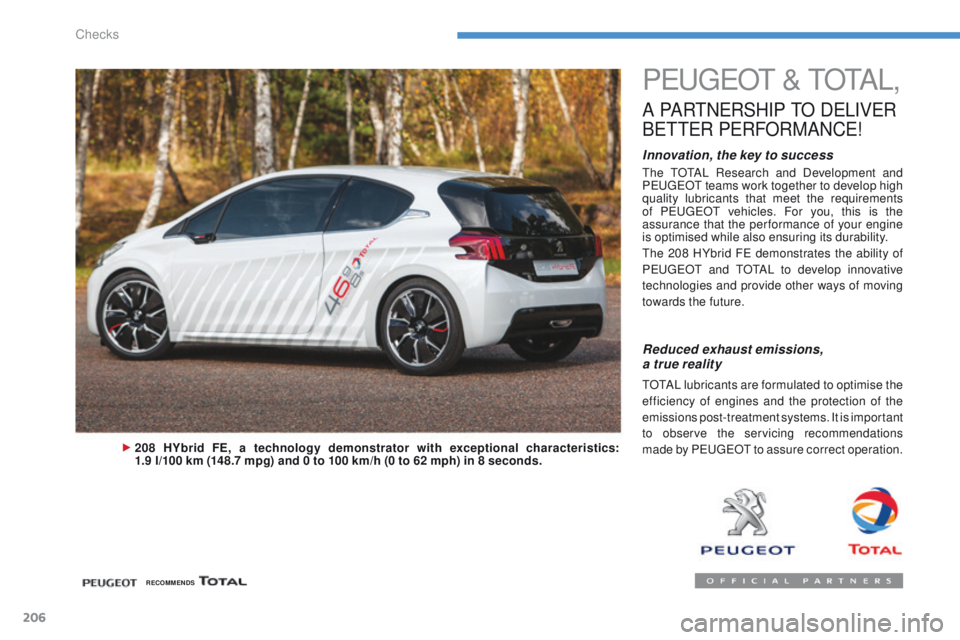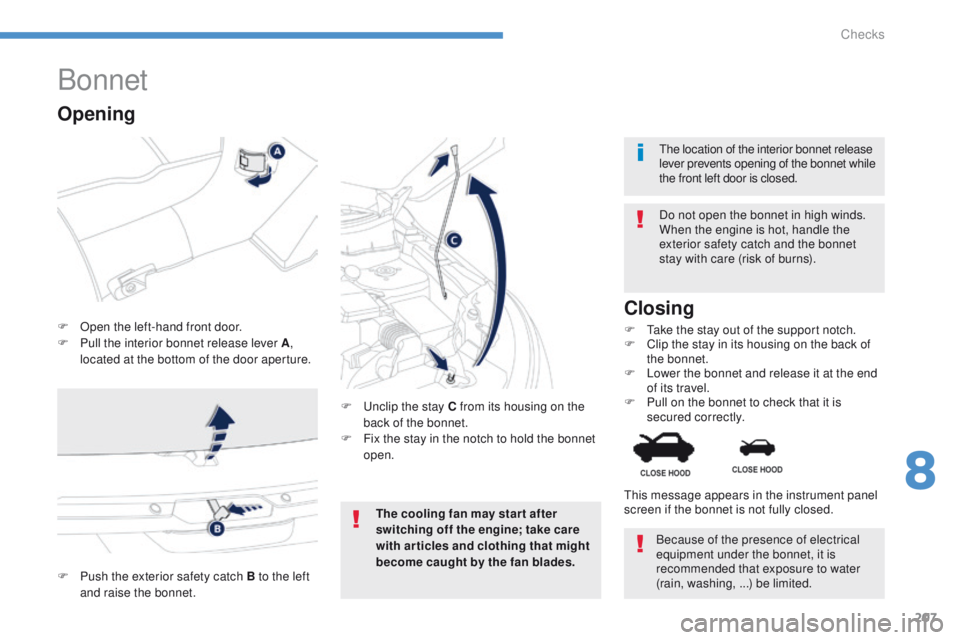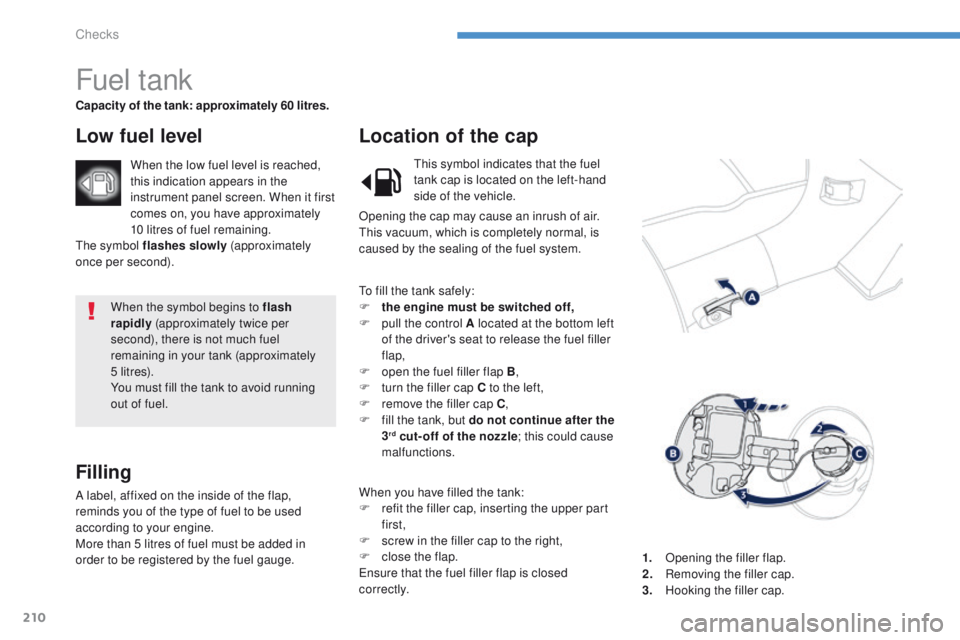Page 199 of 389
197
4008_en_Chap07_info-pratiques_ed01-2014
Removing a front or rear
wiper blade
F Raise the corresponding wiper arm.
F R emove the wiper blade, sliding it towards
the outside.
Changing a wiper
blade
Fitting a front or rear wiper
blade
F At the front, check the size of the wiper blade as the shorter blade is fitted on the
right-hand side of the vehicle.
F
P
ut the corresponding new wiper blade in
place and fix it.
F
F
old down the wiper arm carefully.
Automatic power cut-off to accessories
After the engine has stopped, when the
ignition switch is in the "ACC" position
(or the vehicle in "ACC" mode) you
can still use functions such as the audio
equipment, windscreen wipers, dipped beam
headlamps,
courtesy lamps, etc. for about
thirty
minutes.Cutting off
Once the thirty minutes have expired, the
power supply to the accessories will be
automatically cut off.
Restoring power
the power supply will be restored the next time
the ignition is switched on.
7
Practical information
Page 204 of 389

202
4008_en_Chap07_info-pratiques_ed01-2014
Driving advice
Distribution of loads
F Distribute the load in the trailer so that the heaviest items are as close as possible to
the axle and the nose weight approaches
the maximum permitted without
exceeding
it.
Air density decreases with altitude, thus
reducing engine performance. Above
1
000 metres, the maximum towing load must
be reduced by 10
% of the gt
W a
nd so on for
every 1
000 metres of altitude.
Refer to the "
te
chnical Data" section for details
of the weights and towing loads which apply to
your vehicle.
Side wind
F take into account the increased sensitivity to side wind.
Cooling
towing a trailer on a slope increases the
temperature of the coolant.
As the fan is electrically controlled, its cooling
capacity is not dependent on the engine speed.
F
t
o l
ower the engine speed, reduce your
speed.
th
e maximum towing load on a long slope
depends on the gradient and the outside
temperature.
In all cases, pay attention to the coolant
temperature.
F
I
f this message is displayed, stop your
vehicle as soon as it is safe to do so.
Braking
towing a trailer increases the braking distance.
Ty r e s
F Check the tyre pressures of the towing vehicle and of the trailer, observing the
recommended pressures.
Lighting
F Check the lighting and signalling on the t r a i l e r.
If the message flashes slowly, wait for the
engine to cool before topping up the level,
if
necessary.
If the message flashes rapidly, contact a
P
e
uge
Ot
dealer or a qualified workshop
without delay.
Practical information
Page 208 of 389

206
4008_en_Chap08_verifications_ed01-2014
PeugeOt & t O tA L,
A PARtNeRSHIP tO DeL IVe R
Be
tte R
P
e
RFORMANC
e
!
Innovation, the key to success
the tOtAL Research and Development and
Pe
ugeOt teams work together to develop high
quality lubricants that meet the requirements
of P
e
uge
Ot
vehicles. For you, this is the
assurance that the performance of your engine
is optimised while also ensuring its durability.
th
e 208 HYbrid F
e
demonstrates the ability of
P
e
uge
Ot
and
tOtA
L to develop innovative
technologies and provide other ways of moving
towards the future.
208 HYbrid FE, a technology demonstrator with exceptional characteristics:
1.9 l/100 km (148.7 mpg) and 0 to 100 km/h (0 to 62 mph) in 8 seconds.
Reduced exhaust emissions,
a true reality
tOtAL lubricants are formulated to optimise the
efficiency of engines and the protection of the
emissions post-treatment systems. It is important
to observe the servicing recommendations
made by P
e
uge
Ot
to assure correct operation.
RECOMMENDS
Checks
Page 209 of 389

207
4008_en_Chap08_verifications_ed01-2014
Bonnet
F Open the left-hand front door.
F P ull the interior bonnet release lever A ,
located at the bottom of the door aperture. Do not open the bonnet in high winds.
When the engine is hot, handle the
exterior safety catch and the bonnet
stay with care (risk of burns).
F u
n
clip the stay C from its housing on the
back of the bonnet.
F
F
ix the stay in the notch to hold the bonnet
open.
Closing
F take the stay out of the support notch.
F C lip the stay in its housing on the back of
the bonnet.
F
L
ower the bonnet and release it at the end
of its travel.
F
P
ull on the bonnet to check that it is
secured correctly.
th
e location of the interior bonnet release
lever prevents opening of the bonnet while
the front left door is closed.
Opening
F Push the exterior safety catch B to the left
and raise the bonnet.
th
is message appears in the instrument panel
screen if the bonnet is not fully closed.
The cooling fan may star t after
switching off the engine; take care
with articles and clothing that might
become caught by the fan blades. Because of the presence of electrical
equipment under the bonnet, it is
recommended that exposure to water
(rain, washing, ...) be limited.
8
Checks
Page 210 of 389
208
4008_en_Chap08_verifications_ed01-2014
Access for checking the levels of the various
fluids and the replacement of certain
components.
Petrol engines
1. Screenwash and headlamp wash fluid reservoir.
2.
C
oolant header tank.
3.
B
rake fluid reservoir.
4.
B
attery.
5.
Fusebox.
6.
A
i r f i l t e r.
7.
e
n
gine oil dipstick.
8.
e
n
gine oil filler cap. 1.6 litre 115
2.0 litre 150
Checks
Page 211 of 389
209
4008_en_Chap08_verifications_ed01-2014
the various caps and covers allow access for
checking the levels of the various fluids, for
replacing certain components and for priming
the fuel system.
Diesel engines
1. Screenwash and headlamp wash fluid reservoir.
2.
C
oolant reservoir.
3.
B
rake fluid reservoir.
4.
B
attery.
5.
Fusebox.
6.
A
i r f i l t e r.
7.
e
n
gine oil dipstick.
8.
e
n
gine oil filler cap.
9.
P
riming pump*. 1.6 HDi 110
1.8 HDi 150
* According to engine.
8
Checks
Page 212 of 389

210
4008_en_Chap08_verifications_ed01-2014
When the symbol begins to flash
rapidly (approximately twice per
second), there is not much fuel
remaining in your tank (approximately
5 li t r e s).
You must fill the tank to avoid running
out of fuel.
Fuel tank
Capacity of the tank: approximately 60 litres.
Low fuel level
Filling
A label, affixed on the inside of the flap,
reminds you of the type of fuel to be used
according to your engine.
More than 5 litres of fuel must be added in
order to be registered by the fuel gauge.
Location of the cap
When the low fuel level is reached,
this indication appears in the
instrument panel screen. When it first
comes on, you have approximately
10 litres of fuel remaining.
th
e symbol flashes slowly (approximately
once per second).
1.
O
pening the filler flap.
2.
R
emoving the filler cap.
3.
H
ooking the filler cap.
to f
ill the tank safely:
F
t
he engine must be switched off,
F
p
ull the control A located at the bottom left
of the driver's seat to release the fuel filler
flap,
F
o
pen the fuel filler flap B,
F
t
urn the filler cap C to the left,
F
r
emove the filler cap C,
F
f
ill the tank, but do not continue after the
3
rd cut- off of the nozzle ; this could cause
malfunctions.
When you have filled the tank:
F
r
efit the filler cap, inserting the upper part
first,
F
s
crew in the filler cap to the right,
F
c
lose the flap.
en
sure that the fuel filler flap is closed
c o r r e c t l y.
th
is symbol indicates that the fuel
tank cap is located on the left-hand
side of the vehicle.
Opening the cap may cause an inrush of air.
th
is vacuum, which is completely normal, is
caused by the sealing of the fuel system.
Checks
Page 213 of 389

211
4008_en_Chap08_verifications_ed01-2014
Quality of the fuel used for
petrol engines
the petrol engines are per fectly compatible
with e1 0 type petrol biofuels (containing 10 %
ethanol), conforming to
e
u
ropean standards
eN 2
28 and e
N 1
5376.
e8
5 type fuels (containing up to 85 % ethanol)
are reserved exclusively for vehicles marketed
for the use of this type of fuel (BioFlex
vehicles).
t
h
e quality of the ethanol must
comply with
e
u
ropean standard e
N 1
5293.
For Brazil only, special vehicles are marketed
to run on fuels containing up to 100 % ethanol
(
e
10 0 t y p e).
Quality of the fuel used for
Diesel engines
the Diesel engines are per fectly compatible
with biofuels which conform to current and
future e
u
ropean standards (Diesel fuel
which complies with standard
e
N 5
90 mixed
with a biofuel which complies with standard
eN
14214) available at the pumps (containing
up to 7
% Fatty Acid Methyl e
s
ter).
th
e B30 biofuel can be used in certain Diesel
engines; however, this use is subject to strict
application of the special servicing conditions.
Contact a P
e
uge
Ot
dealer or a qualified
workshop.
th
e use of any other type of (bio)fuel
(vegetable or animal oils, pure or diluted,
domestic fuel...) is strictly prohibited (risk of
damage to the engine and fuel system).
1.6 litre petrol engines, even though they have
been designed to operate on 95 RON petrol,
can accept 90 RON petrol without engine
adjustments, but with a slight deterioration in
performance.
2.0 litre petrol engines can accept 90 RON or
higher petrol.
8
Checks